| << UbuWeb |
| Aspen no. 2, item 4 |
|
|
| Ski Racing: Edging the Possible |
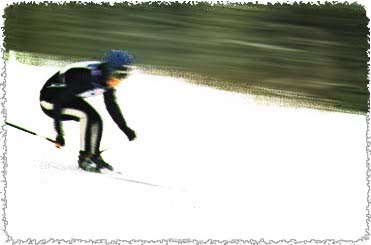
|
|
The only moment I really love is during a race, and afterwards I fall into a sort of a hole, and it is not worth talking about — Francois Bonlieu
To begin with, why do they do it? For ten years now, I have watched them speeding down the pistes of Europe and the United States. Like that dream sequence in the French movie, "Ski Total," where racers take the most terrifying falls, I have seen them seemingly on their way to glory, suddenly hook skis around slalom poles, crash into spectators, plunge over rocks, somersault through the air, and end up bloody and broken.
These nightmarish falls are what dominate my mind when I think about ski racing: Charles Bozon missing a giant slalom gate in the 1958 FIS Games at Badgastein and rolling over and over, finally hitting a rock wall and breaking enough vertebrae to put him out of action for more than a year. Or the late Wallace (Bud) Werner, on his way to victory in the same games, catching an edge in the downhill and sliding at least a hundred feet, a veritable mass of snow, finally ending near the finish line with broken skis.
In last year's Hahnenkamm, by the start of the downhill, six inches of new unpacked snow had fallen. Warm winds, cooled by the snow, had produced an unprecedented fog. Said Germany's Ludwig Leitner, the eventual winner, Ready to risk everything. Why? Ski racers, like competition car drivers, are notoriously inarticulate about what happens during the event, even though they may talk with great intelligence about everything else. "How was it?" you ask. They have just shot through a bewildering array of 80 slalom gates over terrain that just to ski would scare the stretch pants off any recreational skier: moguls, gullies, walls of snow. "A good course," they say. Or, "I didn't have any trouble with it." Some, like the Swiss champion Jos Minsch, or the tiny self-contained Frenchman Francois Bonlieu, say nothing. Methodically, they unwrap their long-thongs, remove their skis, show little interest in their racing times, and walk away. Tony Sailer never talked to anyone after flashing through the finish line, but always turned and stared silently at the course. I think the essence of ski racing lies in one word — challenge. All great athletes are alike. Physically, they are reaching for the unknowable —a new limit to speed, to height, to distance—perhaps in this way they define their own limits. Francois Bonlieu, when he became Olympic Giant Slalom Champion in Innsbruck in 1964, was asked, "How long will you continue to race?" "I will continue until I am, 40, 50, 60 years old," he replied. "Ski racing is the most beautiful thing in the world." French champion Guy Perillat, probably one of the most competent downhill racers in the world, was asked by an interviewer why he loved to go so fast. He replied, "One must." Stein Eriksen has put it to me that the top racer aims at "staying on the edge of what is possible." When he was preparing for the 1948 and 1952 Olympics, he always made it a point to ski a hair's breadth faster than he normally would during competition. |

|
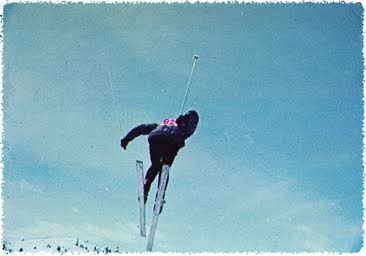
|

|
|
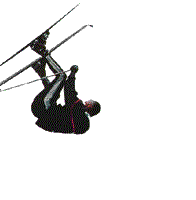
|
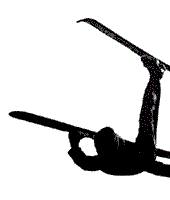
|
||
|
"I fell a lot," he says. "But each training session, I fell less and less until finally I reached the limit of what I knew I could do." To Stein, "staying at the absolute climax of balance" is the nub of ski racing, and in fact, the total sport. To Bob Beattie, U.S. Olympic ski coach, downhill racing is an elusive combination of technical know-how, judgment, reflexes, nerves, courage, and strength. "The racer who performs well in downhill enjoys the greatest of skiing thrills. He has learned to conquer himself," he wrote last year in Skiing. What does it take to be a racer in this category, to be within the sight of glory, or even to reach it? The core of every champion racer is composed of incredible will. Ski racing means intense, solitary training. Years and years of it. A racer's life borders on almost fanatic devotion to building his physical strength, with incredibly long hours spent in running gate after gate in slalom, in schussing mile after mile of downhill trails. And once he becomes good enough, nothing else will do but to win. Bud Werner, who was the only American ever to win a European downhill race, but in ten years of racing failed to score in an Olympics or in an FIS championship, said, before Innsbruck, "There are only two places in the race, and I only want one of them." What he wanted was that gold medal and to the day he died in an avalanche in Switzerland, it remained out of his reach. Each race requires absolute concentration on the job at hand. Werner, for example, was unapproachable before important races. It wasn't lack of courtesy on his part, he was always a polite, quiet person. It was just that he had disappeared inside his mind, as it were, running and rerunning the course he would race the following day. On the mountain itself, concentration again is paramount. One must plan the race with utmost precision, memorizing and evaluating each bump and turn, seeking and finding the shortest route. The ability to memorize sets of gate combinations becomes rote. For example, a giant slalom gate concealed on the other side of a hollow becomes very important. This happened to America's Jim Heuga in the Olympic Giant Slalom in 1964; he simply forgot the gate was there and was headed the wrong way when he came out of the hollow. At the starting gate, the racer's mind seems to focus down to the most minute detail. Here is Stein Eriksen at the start of the 1952 Olympic Slalom where he placed second: "Everything is in order, except for my skis. There is some snow on my left ski, and it has to be brushed off. This has no practical importance, but seeing the snow there bothers me. Both skis must look the same. I have to see the beautiful grain of the wood shining through the varnish equally on both skis. It's silly, I know, but suddenly, very important." This leads to the question of fear. In ski racing, lack of fear seems to be a function of technique. That is to say, the better a racer is technically—the more he is able to handle the problems of terrain, of speed, of picking the shortest possible line between difficult gate combinations—the less fearful he is of the course. To the spectator, watching a racer cling to the gigantic mogulled near-cliff that is Sun Valley's Exhibition Run, it all seems like madness. But the racer not hung up by fear is less concerned with speed than with the immediate problem of making his turn in the next gate so he will be in a' direct line with the following one. The racer with the best downhill technique, the one who does not allow terrain variations to throw him into the air and at the same time is able to push for that extra margin of speed, is going to be the winner. Ski racing is a simultaneous trial of physical skill and mental dexterity, and it is not always physical strength that makes a good racer. The late German racer, Barbi Henneberger, a national champion who was killed in the same avalanche that ended Bud Werner's life, was a slight girl with little of the physical strength of her compatriots. "It's all up here," she told me after the 1963 Harriman Cup, pointing to her head. "I'm not as strong as some of the others, so I use my brain." She was quick and lithe, but her forte was strategy, the ability to conserve her strength so that she had it when she needed it. There is a parallel, I think, between ski racing and mountain climbing, because each takes total absorption to do well and in each, the challenge is one of trying to find one's own limits. This may be why some famous skiers have been outstanding mountain climbers: Lionel Terray, one of the survivors of Annapurna, a man who made countless first ascents in the Alps, Andes, and Himalayas, was a ski racer. So was Charles Bozon, a lean, quiet youth who loved alpinism almost as much as he loved to race. There is a great similarity between Perillat saying he races because "he must" and George Leigh mallory's answer to the question of why he climbed mountains: "Because they are there." Bozon died in a terrible avalanche in the flanks of Mont Blanc two seasons ago; his grave is in Chamonix where Terray now also lies. Some years ago, for the French publication, Ski Moniteur, he wrote a description of how he won the slalom championship at the 1962 FIS games in Chamonix. If there is such a thing as a mystique to ski racing, this is what it was to Charles Bozon: "On this day, I am very calm. There will be a storm today. How well I know the mutton sky just hanging level with the first pine trees of Les Bossons. Yet for me, there is a great calm. "Until eleven o'clock, in the peace and silence of my little chalet, I prepare my skis once more. It is difficult to believe that this day which I have waited for so long has really come. Once again I remember the slalom races of the winter, and the slow certainty of success comes to me, filling me with serenity. "I know by heart the slalom course at Le Mont. It pleases me, while the qualification slalom last Saturday was much more difficult. Then the moment comes. I am alone in the biting snow and the bursts of wind which have erased all familiar things; even the other competitors are of little importance. There is no longer any question of checking equipment. The event must come to pass. To rest calm, concentrate but calm. I must give the illusion of going slowly—but only the illusion. Be careful at the final gates, there where one would like to let up. Finish the race as begun. This is not easy. "The first heat is won. Now it is necessary to eat, relax, sharpen the edges of my skis until they are perfect, keep warm and calm. I climb the length of the slalom course with the cadence of the mountaineers in the storm. I know that cadence well. All the way up, I am encouraged by the assuring remarks of my friends. "The second heat has started. I am fully in the spirit of the track. Good. But further on, I feel I am not descending fast enough. I accelerate. I enter a great squall. All disappears and the snow clings to my goggles. A moment of insecurity. Has everything been lost? Even though I am near the bottom, I relax. My skis separate in all directions. That which I so feared has happened. Ouf! One must close them, pass, pass, that's it. This is the way. "My time has not been announced but everyone believes me the winner, and even me, I believe it. Nenning is on the course. Will he be better? No, his time is greater than mine. Then comes the explosion—the tears of Bonnet (the French coach), of all my friends. I did not know that I had so many." |
|||
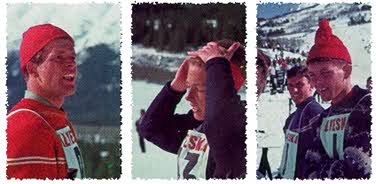
|
|
Original format: Single horizontal page, 45 inches by 6-1/8 inches, accordion-folded into booklet covers, 4-3/4 by 6-1/8 inches. Text and photos by Martin Luray. Several photos are omitted here to conserve download time. |
|
|
|
|
|
|
|
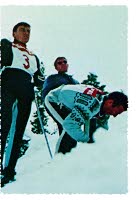 I have seen them ski through fog, like Anderl Molterer did on Kitzbuhel's dangerous Streif, mist so thick a cat couldn't have found its day down the trail. And yet Molterer did, in the 1958 Hahnenkamm and won, and said without the trace of a tremor, "I could have done it blindfolded."
I have seen them ski through fog, like Anderl Molterer did on Kitzbuhel's dangerous Streif, mist so thick a cat couldn't have found its day down the trail. And yet Molterer did, in the 1958 Hahnenkamm and won, and said without the trace of a tremor, "I could have done it blindfolded."
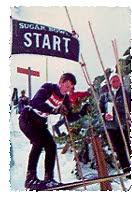 Or Tom Corcoran in the same race, falling in nearly the same place, tumbling like a dervish until finally on his feet he turned around, his stretch pants split—a glimmer of red longjohns showing. In the great crowd, his teammates watched, tears on their faces for Corcoran and Werner. Or Billy Kidd, in last year's slalom at Vail's ThreeWay International races—the man who was expected to recoup for America and rescue it once again from near-oblivion, falling fantastically with the race almost won and sliding irremediably out of it all. I have seen races, where despite the frantic efforts of the organizers, the pistes were paths of ice, or rutted with bony ridges of hard, concrete-like snow, or with rocks edging through the cover, a trap for the unwary. The racers ran anyway.
Or Tom Corcoran in the same race, falling in nearly the same place, tumbling like a dervish until finally on his feet he turned around, his stretch pants split—a glimmer of red longjohns showing. In the great crowd, his teammates watched, tears on their faces for Corcoran and Werner. Or Billy Kidd, in last year's slalom at Vail's ThreeWay International races—the man who was expected to recoup for America and rescue it once again from near-oblivion, falling fantastically with the race almost won and sliding irremediably out of it all. I have seen races, where despite the frantic efforts of the organizers, the pistes were paths of ice, or rutted with bony ridges of hard, concrete-like snow, or with rocks edging through the cover, a trap for the unwary. The racers ran anyway.
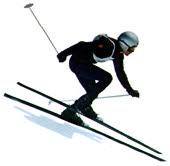 "Twice during the race, I did not see a thing—nothing. But I ran blind, I was ready to risk everything."
"Twice during the race, I did not see a thing—nothing. But I ran blind, I was ready to risk everything."